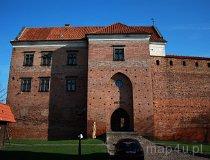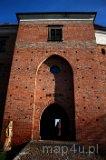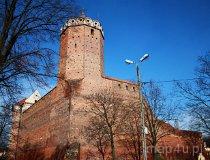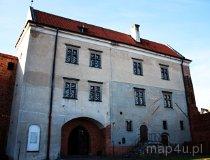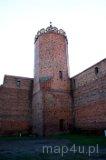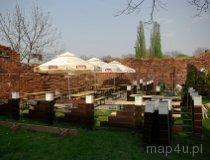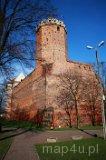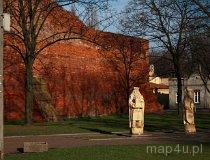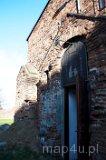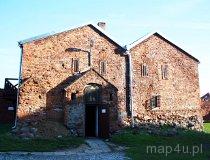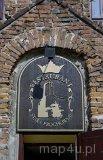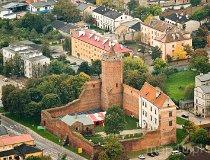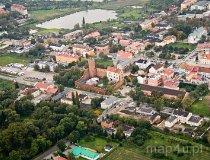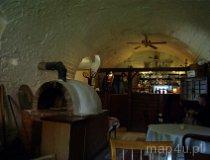Castle complex in Łęczyca
Description
The royal castle was based on a rectangular plan 61 m long and 46 m wide. It was made of red brick. The entrance is through a large gate adjoining the three-storey residential building called "the new house." Currently, it houses the Museum of the Region of Łęczyca. In the south-west corner of the walls there is a high tower, which is four-sided at the bottom and octagonal above the walls. From its top there is a wonderful view of the whole Łęczyca and surrounding fields. At the courtyard there survived the remains of the so-called old house, which in the Prussian times were converted into an ammunition depot (hence it current name "prochownia" - "powder magazine"). Currently, is houses a small atmospheric restaurant with stylized interior including a bread stove.
Date or time of building
XIV w.
Zamek wybudowany w poł. XIV w., przebudowany w XVI w. oraz na początku XIX w. Po obróceniu w ruinę w XIX w., stopniowo odbudowany w okresie międzywojennym i przede wszystkim w latach 1964–1976.Date or time of building
The 14th century
The castle was built in the second half of the 14th century and reconstructed in the 16th century and at the beginning of the 19th century. Having fallen into ruin in the 19th century, it was gradually reconstructed in the interwar period and, above all, in 1964-1976.
Building material
Brick and stone.
History
The castle in Łęczyca was built around 1350 on the initiative of Casimir the Great as one of royal residences, but also, above all, as one of fortresses which were supposed to defend the country. Its outer walls were incorporated into the south-east corner of the system of the town's fortifications. The castle, surrounded by a moat, was based on an approximately rectangular plan. A two-storey Gothic house used to adjoin the east wall. It was called "the old house" and held the great hall, where the king received audiences. In the west wall there used to be a gate building with an entrance hall, to which a two-storey Renaissance building was added in the middle of the 16th century. In the 15th century and the first half of the 16th century the fortress was destroyed by several fires. The castle, in times of its prosperity, was visited by kings and church and state dignitaries. Political events and ceremonies took place there. The rulers who spent the longest time in the Łęczyca castle were Ladislaus Jagiello and Casimir Jagiello. During their reigns many important political decisions were made in Łęczyca. With time, the castle became the seat of starosts, including Jan Lutomierski, the Łęczyca starost and an eminent figure in Renaissance Poland.
In 1655 the Łęczyca castle and the town were conquered by the Swedish army. The Poles did not regain it until the early October 1656, after bloody storm, during which the castle was much damaged. In subsequent years, despite damages, the castle was still used, but it was falling into ruin. It was not reconstructed until the turn of the 18th and 19th centuries, when the Prussian converted it into a fortress and incorporated it into a system of fortifications. They destroyed most of the walls of the "old house", which was converted into an ammunition depot, currently called "prochownia" - "the powder magazine". In 1841 the top part of the tower collapsed and the whole castle fell into ruin. Some elements were not strengthened until the interwar period, thanks to public funding. Another good period for the castle came after the second world war, when the Museum of the Region of Łęczyca was established. It started collecting exhibit items connected with the castle and the Region of Łęczyca and first exhibitions were opened in the castle. Then archaeological and conservation works took place in 1964-1976. In that period the castle regained its former glory and permanent museum exhibitions appeared in its rooms.
Type of collection
The Museum of the Region of Łęczyca, with the seat in the so-called "new house", has collected numerous exhibit items connected with the history of the castle, the town of Łęczyca and the surrounding area. The exhibition is divided into four sections: historical, ethnographic, archaeological and artistic. The collection of the museum includes, inter alia: traditional craft and folk art of the Region of Łęczyca, weaponry and furnishing of the Łęczyca castle, works of arts from various periods collected in Łęczyca during the centuries, items found by archaeologists in the vicinity of the town and numerous prints, documents and reconstructions of historic items.
Curious details
There are legends about the devil Boruta, living in the vault of the Łęczyca fortress. One of them tells that he was a nobleman, who, during the reign of Casimir the Great, settled in the castle as a reward for helping the king. As a result of breaking promises given to later rulers of Mazovia, he was imprisoned in the vault of the fortress, where he guards a treasure. There are many more legends about Boruta, but there is no doubt that this sympathetic and a bit swashbuckling devil became an unquestionable symbol of Łęczyca. It can be proved by the largest collection of demonological sculptures in Poland, which is a part of the exhibition in the Łęczyca castle.
Every year the International Knights' Tournament takes place in Łęczyca. Knights' brotherhoods and enthusiasts of medieval weapons come to the town from all Poland and several other European countries. During the tournament numerous guests can admire the knights' fighting shows, archery competitions, medieval dance shows, medieval workshops, merchants' stalls and many more attractions. The tournament is accompanied by the great medieval fair and shows or traditional Italian sbandieratori (flags juggling).
At the castle there are also organized other events, including "the Fair of the Benedict of Poland", exhibitions and tournaments of school knight's teams.
Form of legal protection
The entries in the Voivodeship Register of Historic Monuments:
- The castle complex - the east house - powder magazine, registry number: 87-V-11 of May 15, 1946
- The castle complex - the east house - powder magazine, registry number: 74/279 of July 26, 1967
- The castle complex - the new house, registry number: 80-V-4 of May 15, 1946
- The castle complex - the new house, registry number: 73/278 of July 26, 1967
- The castle complex - the tower and the walls, registry number: 91-V-15 of May 15, 1946
- The castle complex - the tower and the walls, registry number: 75/280 of July 26, 1967
Object location
The castle is located in the centre of the town, around 50 m to the east of Kościuszki Square (the Old Town market square), next to Zamkowa Street and the national road no. 1
Accessibility
The castle is freely accessible from the outside. The courtyard is open during the working hours of the museum free of charge. The entrance to the museum is paid.
The opening hours of the museum:
- during the tourist season (from the 1st of May to the 30th of September):
Tuesday-Friday, from 10 a.m. to 5 p.m.,
Saturday, Sunday and holidays, from 11 a.m. to 5 p.m.
- outside the tourist season:
Tuesday, from 10 a.m. to 5 p.m.,
Wednesday-Friday, from 10 a.m. to 4 p.m.,
Saturday, Sunday and holidays, from 11 a.m. to 3 p.m.
On Mondays the museum is closed.
Parking
Next to the castle there is a parking lot accessed from the national road no. 1.
Sources, links
- Mokras-Grabowska, J and P. Rzeńca. Województwo Łódzkie - Przewodnik Turystyczny. Łódź , 2007;
- Łęczyca. Informator Turystyczny, 2005;
- www.zamek.leczyca.info.pl;
- www.powiatleczycki.republika.pl;
- www.pit.leczyca.info.pl.
Other
The "Stara Prochownia" restaurant, located in the powder magazine at the courtyard, offers Polish cuisine and weak alcohols. It has 15 seats inside and a small tea garden outside.




